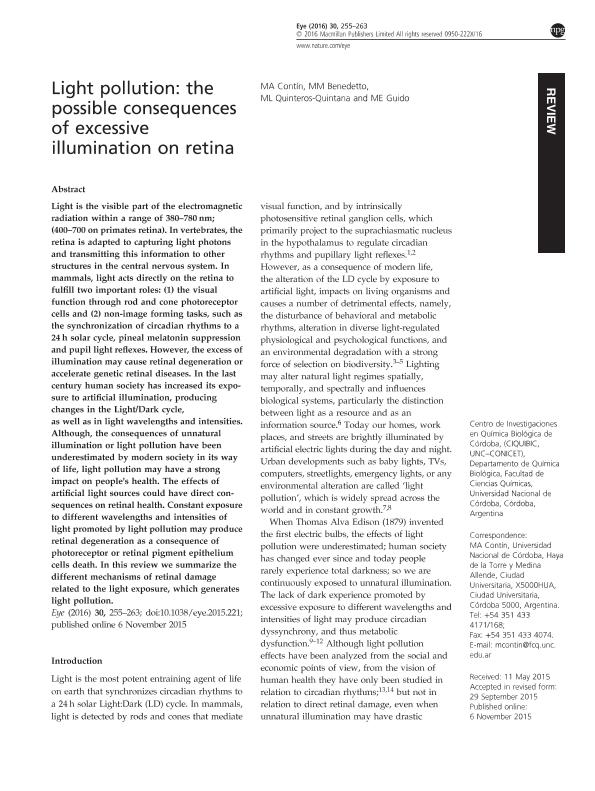Mostrar el registro sencillo del ítem
dc.contributor.author
Contin, Maria Ana

dc.contributor.author
Benedetto, María Mercedes
dc.contributor.author
Quinteros Quintana, María Luz

dc.contributor.author
Guido, Mario Eduardo

dc.date.available
2021-04-27T11:11:55Z
dc.date.issued
2016-02
dc.identifier.citation
Contin, Maria Ana; Benedetto, María Mercedes; Quinteros Quintana, María Luz; Guido, Mario Eduardo; Light pollution: The possible consequences of excessive illumination on retina; Nature Publishing Group; Eye; 30; 2; 2-2016; 255-263
dc.identifier.issn
0950-222X
dc.identifier.uri
http://hdl.handle.net/11336/130873
dc.description.abstract
Light is the visible part of the electromagnetic radiation within a range of 380-780 nm; (400-700 on primates retina). In vertebrates, the retina is adapted to capturing light photons and transmitting this information to other structures in the central nervous system. In mammals, light acts directly on the retina to fulfill two important roles: (1) the visual function through rod and cone photoreceptor cells and (2) non-image forming tasks, such as the synchronization of circadian rhythms to a 24 h solar cycle, pineal melatonin suppression and pupil light reflexes. However, the excess of illumination may cause retinal degeneration or accelerate genetic retinal diseases. In the last century human society has increased its exposure to artificial illumination, producing changes in the Light/Dark cycle, as well as in light wavelengths and intensities. Although, the consequences of unnatural illumination or light pollution have been underestimated by modern society in its way of life, light pollution may have a strong impact on people's health. The effects of artificial light sources could have direct consequences on retinal health. Constant exposure to different wavelengths and intensities of light promoted by light pollution may produce retinal degeneration as a consequence of photoreceptor or retinal pigment epithelium cells death. In this review we summarize the different mechanisms of retinal damage related to the light exposure, which generates light pollution.
dc.format
application/pdf
dc.language.iso
eng
dc.publisher
Nature Publishing Group

dc.rights
info:eu-repo/semantics/openAccess
dc.rights.uri
https://creativecommons.org/licenses/by-nc-sa/2.5/ar/
dc.subject
Retina,
dc.subject
Photoreceptors
dc.subject
Retinal Degeneration
dc.subject
Light Damage
dc.subject
Light Pollution
dc.subject.classification
Otras Ciencias Químicas

dc.subject.classification
Ciencias Químicas

dc.subject.classification
CIENCIAS NATURALES Y EXACTAS

dc.title
Light pollution: The possible consequences of excessive illumination on retina
dc.type
info:eu-repo/semantics/article
dc.type
info:ar-repo/semantics/artículo
dc.type
info:eu-repo/semantics/publishedVersion
dc.date.updated
2021-03-26T19:37:59Z
dc.identifier.eissn
1476-5454
dc.journal.volume
30
dc.journal.number
2
dc.journal.pagination
255-263
dc.journal.pais
Reino Unido

dc.journal.ciudad
Londres
dc.description.fil
Fil: Contin, Maria Ana. Consejo Nacional de Investigaciones Científicas y Técnicas. Centro Científico Tecnológico Conicet - Córdoba. Centro de Investigaciones en Química Biológica de Córdoba. Universidad Nacional de Córdoba. Facultad de Ciencias Químicas. Centro de Investigaciones en Química Biológica de Córdoba; Argentina
dc.description.fil
Fil: Benedetto, María Mercedes. Consejo Nacional de Investigaciones Científicas y Técnicas. Centro Científico Tecnológico Conicet - Córdoba. Centro de Investigaciones en Química Biológica de Córdoba. Universidad Nacional de Córdoba. Facultad de Ciencias Químicas. Centro de Investigaciones en Química Biológica de Córdoba; Argentina
dc.description.fil
Fil: Quinteros Quintana, María Luz. Consejo Nacional de Investigaciones Científicas y Técnicas. Centro Científico Tecnológico Conicet - Córdoba. Centro de Investigaciones en Química Biológica de Córdoba. Universidad Nacional de Córdoba. Facultad de Ciencias Químicas. Centro de Investigaciones en Química Biológica de Córdoba; Argentina
dc.description.fil
Fil: Guido, Mario Eduardo. Consejo Nacional de Investigaciones Científicas y Técnicas. Centro Científico Tecnológico Conicet - Córdoba. Centro de Investigaciones en Química Biológica de Córdoba. Universidad Nacional de Córdoba. Facultad de Ciencias Químicas. Centro de Investigaciones en Química Biológica de Córdoba; Argentina
dc.journal.title
Eye

dc.relation.alternativeid
info:eu-repo/semantics/altIdentifier/url/http://www.ncbi.nlm.nih.gov/pubmed/26541085
dc.relation.alternativeid
info:eu-repo/semantics/altIdentifier/doi/http://dx.doi.org/10.1038/eye.2015.221
Archivos asociados
